The term ‘combat boot’ can mean a lot of different things to a lot of people.
However, I think that most of us envision the classic polished black boots soldiers wear when we hear the words ‘combat boot.’
For a long time, those classic high-ankle combat boots were the only option for anyone wanting to purchase a set for themselves.
In 2023 however, dozens of companies manufacture tactical footwear that would be considered combat boots.
Where To Buy Combat Boots
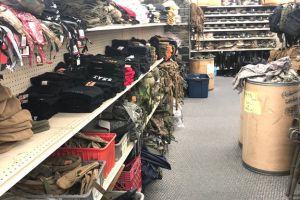 Many people will head to the local army surplus store when they start looking for a set of combat boots.
Many people will head to the local army surplus store when they start looking for a set of combat boots.
While this option has merits, it is better to go to the local outdoor store or online.
Related: The Ultimate SHTF Plan From An Army Vet
This way, you can take advantage of the latest technologies rather than whatever was built into the used boots you would find at a surplus store.
When purchasing combat boots, there are several factors that you need to consider.
Terrain
The terrain you plan on operating in will be a significant driving force in your decision when purchasing your boots. Boots appropriate for the rocky slopes of mountains will not fare well in the desert or swamps.
A waterproof stiff-soled boot with excellent ankle support is great for the high mountains, while a breathable, lightweight and flexible boot is better for the more arid regions.
The good news is that finding a boot well suited for the terrain you want to use it in is quite simple. Manufacturers build boots with a specific landscape in mind, so there is probably a tactical or combat boot that is ideal for the environment you want to operate in.
Climate
The climate will also be a major driving factor in your decision-making process; whether desert or tropical, breathable boots will be the best option if you live in a hot environment. However, waterproof boots should be considered if you live in a temperate rainforest.
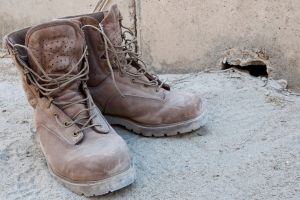 Even though I live in the Pacific Northwest, my boots are desert boots and not waterproof.
Even though I live in the Pacific Northwest, my boots are desert boots and not waterproof.
When I use them in wetter conditions, I use a Gore-Tex sock. This way, I can have a lightweight boot for September hunting trips while also having the ability to wear them when it is raining.
Related: How to Supplement Your Potable Water Supplies by Cheaply Harvesting Rainwater
You cannot get away with one set of boots in many areas. You will need two or even three sets of combat boots, one for the hot summers, another for the cold winters and maybe one for the wet weather.
Material
Most traditional combat boots are made from leather which is a fine option for you to consider. However, many other options are available, sometimes just as effective and durable as leather.
Other material options include nylon, polyester, Gore-Tex, and Kevlar. A boot for hotter climates is best constructed from breathable fabrics instead of leather. On the other hand, in wet climates, Gore-Tex will give you a boot with excellent waterproofing.
One thing to watch out for is quality stitching. The stitching in a boot will often be the first failure point, so make sure everything is at least triple-stitched with high-quality thread.
Ankle Support
A significant advantage to combat boots is that they provide a higher level of ankle support which is vital regardless of where you plan to walk.
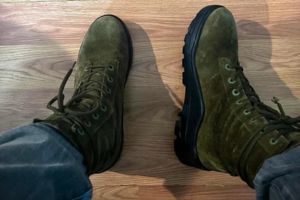
A rolled ankle is bad at the best of times, but post-SHTF, it can be deadly.
Boots meant for the high mountains will have much more support in the ankle than other boots.
They are designed for use on uneven, rocky terrain while carrying a heavy load.
Lighter combat and tactical boots will also have good ankle support but be designed with more mobility in mind.
Tread
The soles of your boots are the only part of you making constant contact with the ground. They are also the thing that will keep you from slipping and sliding all over whichever terrain you happen to be traversing.
It may seem that all boots would have equally decent tread, but this could not be further from the truth.
The rubber your boot soles are made from will make a significant difference in not only the comfort the boots will provide but also their ability to grip surfaces and how fast they will wear out.
Related: How to Make Your Boots Last Longer
Harder soles will wear slower while not absorbing as much of the impact of each step, but softer soles will be more comfortable but wear much faster. It is best to find a boot that falls somewhere in the middle.
The pattern of the tread is also important to consider. Deeper treads are best for muddy or sandy terrain, while shallow treads are ideal for hard-packed surfaces.
Should You Buy A Boot With Steel Toes?
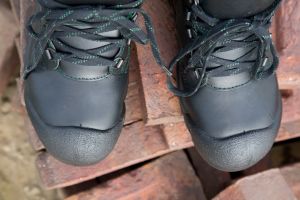 It may seem like a promising idea to have a combat boot that has a steel toe and steel shank.
It may seem like a promising idea to have a combat boot that has a steel toe and steel shank.
Especially in a post-SHTF world where you will be moving through areas that have seen a lot of destruction, not worrying about taking a nail through the sole seems like a good investment.
The problem is that steel toes and shanks will absorb the cold, which will, in turn, make your feet cold. They will also make the boot much stiffer and may hinder your ability to move your foot effectively.
If you decide to buy a boot with these features, choose carbon composite instead of steel because they will not make your feet cold and will be far lighter and more comfortable to wear.
Color Or Camouflage
The combat boots that most soldiers have been issued over the decades have been black, but when we purchase combat boots for our use, we have many color or camouflage options to select from.
Personally, I am not a fan of camouflaged boots. I have never seen much value in them, especially as they get dirty and covered in muck and grime.
I have found that tan or khaki boots blend into many different environments more effectively than standard black boots, which often stand out like a sore thumb.
Choosing a combat boot is very personal, and it can take some time to find one you like. While in many cases, there will not be a one size fits all boot for every scenario you may encounter, you should be able to find boots that will fit a variety of scenarios quite nicely.
The best advice is to choose wisely because bad boots can sideline you quickly, and post-SHTF is not the time to have your feet fail you.
You may also like:
 Meal In A Bag: Sweet And Spicy Meat And Rice
Meal In A Bag: Sweet And Spicy Meat And Rice
You Will Not Survive An EMP Without This (Video)
50 Foods You Can Turn Into Powder
The Best Places Where You Can Store Fuels Safely In An Emergency

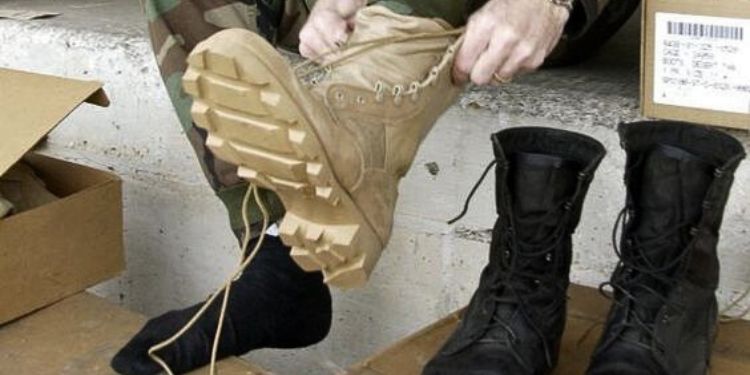













I had some really nice $140 waterproof boots shortly after high school, but, unfortunately, their super soft soles, while very comfortable and grippy, wore out very quickly. The local shoe repair guy wanted over $50 to replace the soles. Good article, good info. Especially the warning about rolling an ankle. A good boot will give good ankle support, and preventing a rolled ankle is very important. My next boots might be Kenetrek boots.
Combat Boots 101, and you didn’t discuss the most important aspect: fitment.
Military Grade or Law enforcement Grade is Best
If you buy cheep , dont expect it to last
The support , the Grade of leather , Thickness of Material , Quality of Workmanship
Bates is one of the Best
also , Firefighter Grade are Excellant
Snake boots for hardened enviornment s
Buy for the type of area your in
Big 5 on line will sell you 50 $ boots , good for about 6mths to a year
no reinforcement
Remember the Survival Rule
Protect your feet , Head , hands
Bata brand.
Military grade just means cheaply made with quality material. Ppl forget that they make military issued gear for tens to hundreds of thousands. They don’t put the fancy stuff into it that you can buy from a good company. Look at military roughsacs/backpacks. Like actually military issued… Then look at all the way way better options. I went the military grade route. And now have upgraded it all to better stuff.
One of the places where you get what you pay for…
Another good article;
One downside of getting any boot or shoe in used condition is the previous owner’s foot wear pattern. May not be the same as ours, the boot sole tread pattern wear is off.
Which means you’ll need to break in your wear pattern like a new set of boots. Or replace the sole tread if you can find a reputable shoe repair shop.
Nothing really wrong with previous owned boots, just be sure they are in good condition.
New old stock, never worn surplus boots are the best way to go. Be careful as surplus stores also carry fake USA military boots made in China too.
Buy American when possible to support our non-union & union workers in the USA.
Steel toe is great for some working environments.
Something to consider on steel toed boots;
In a SHTF situation there the possibility from an accident that the steel toe is crumpled down tight on your foot. Resulting in trying to extract your foot from the boot a problem. Especially when there are no emergency services around in a SHTF scenario to help you.
since clinton our military footwear including boots have been outsourced to China.
Good article. While I do buy “throw away boots” for rough use around my property, better quality is needed for forced, long term use. Don’t forget foot powder and quality wool socks.
I had Gortex Matterhorns that I wore in the jungles of Panama to the high country of Colorado.
I used to be real particular about having the proper boots, years ago I was hanging out with some wilderness guides who hiked and biked everywhere in the mountains and deserts wearing sandals, also wearing cargo shorts, also shirtless. Have since read accounts of Vietnam era SEALS going on combat patrols in their shower shoes, of course the VC were running all over the jungle in their Michelin sandals. So more often than not I wear flip flops everywhere, gardening, doing my little construction projects, working out, even in the winter time. Still have all my toes (and most of my teeth).
something in common across time and the globe – you name the conflict and there was a desperate hunger for decent footwear >>> the Battle of Gettysburg jumped off early because a few Confederates broke camp and came into town looking to loot the local stores for boots ….
subject is “combat boot” – can come in many forms – you need the wide variety of your current daily wear in stockpile multiples – as much need for the softer wear as the durable all terrain boot – don’t think you’ll be wanting to be combat laced up in a basement shelter for a couple of weeks or be out in the garden working the dirt in leather …..
and don’t forget the repair & maintenance supplies in the stockpile – you’ll be needing to replace laces, repair soles and just keep up the natural materials involved …..
more than ever the US is dependent on JIT shipping from overseas – footwear is one of the items that is a US domestic manufacture survivor – still have leather manufacture that makes it profitable >>> everybody should be aware of the empty shoe department shelves during COVID – shows quikly what happens when the ships don’t sail – a wrong season SHTF and there won’t be US stock for the next seasonal change in clothing/shoes …..
Great article !!!
To your point and readers comments…
My left ankle was replaced, right ankle fused. Both problems started with rolled ankles from poor selection of sneakers and boots. Now I need custom fitted shoes, sneakers, and boots. Been going to a family owned business in Eastern PA, for custom foot apparel, for over 25 years. They are the best.
I constantly stress the importance of having the correct shoe apparel for all conditions. As everyone here knows a reduction in the ability to walk or run makes you the guy staying behind to delay the zombies from catching the main group as well as dying in the process.
Once again, great article
Regards,
Military boots come in all sizes. Choose wisely. Break in before any serious hiking or load bearing. Good fitment and socks will save a your feet. Carry mole skin and foot powder. Extra socks to change regularly. The lightweight boots (jungle, desert, ranger…ect) lesson fatigue. Snakes, thorns, sharp brush, broken bottles, and splintered wood all test your resolve. Embers as well as flame make synthetic materials a concern. Leather boots with thorn proof soles are the very best general use choice. Know your limits, terrain, and purpose.
Steel toes are useful if you are moving wheeled equipment. I’ve seen them run over by a deuce-and-a-half with no hurt except fright. Be careful when sitting around the fire because the steel will heat up and your pain will be directly proportional to the time it takes you to get the boots off.
I keep duct tape to stretch over my heel or ball of foot to prevent or treat blisters. Has saved me many times.
Good article.
I do have a few thoughts since I have been a boot wearer for most of my life. And I have had to wear boots since I did major damage (found out years later from an x-ray that I had actually broken a couple of bones in my left ankle) to my left ankle when I came down on the edge of a concrete driveway stepping off the wheel fenders of a trailer with about thirty pounds in my right hand. And I weighed close to 250 pounds at the time.
I rolled that ankle big time. I could not go to the doctor for it, so I got my father’s crutches he had used when he was knocked off a ladder and landed on a concrete driveway. We were headed to Michigan to pick cherries for the summer with my two younger brothers and a cousin. I hobbled around on the crutches on the ground and climbed the ladders with one foot and pulled myself up with my arms.
I finally could quit using the crutches and still get around, but as fate would have it, I rolled that same ankle about two weeks later and was back on the crutches for another month before my ankle would support my weight. The pain those two times are up there in the top five pain instances of my life.
Of course, I had to wear boots after that all the time to protect the ankle. I wore Redwing slip-ons, though I should have been wearing laced boots. I had begun running again after my ankle healed enough to do so and worked my way up to about a 30-pound pack, rifle, and rope, doing three miles a night for several years. And then, of course, I stepped wrong on a broken section of sidewalk and went down. Crutches again and no running.
Anyway, protect your feet. Use some form of quality boot, the taller the better, that can lace tightly. Be careful of insulated boots. They are fine in the winter but can overheat your feet in the summer. I prefer to use standard boots and wear appropriate layering socks for winter. I do get boots that are slightly oversize but break them in with standard wool field socks and not the heavy ones I wear with silk liner socks, regular merino wool socks, and heavy merino wool over-socks.
I believe, through my own experience and from talking to others, that while ‘breaking-in’ boots does allow the boot to adjust to your feet/socks, your feet also ‘break-in’ to the boot, as well. Your feet will adjust (not the best word choice but I cannot think of a different one) much the same way the material of the boot does to the small changes between what you had worn and the new boots. So, give it some time and break the boots in slowly until both your feet and the boots have found the most comfortable fit.
When I have been able (had the money), I would buy a new pair of boots and get them well worn in and then get another pair and set that first pair aside in storage, and break-in the near pair and were them until the were about 3/4 of the way through their life. I would get another new pair, break them in and then store them, using the first pair that I had store to 3/4 of their life.
This allowed me to always have a pair of boots that fit me well, in case I ruined the pair I wore normally, or needed to have them repaired, cleaned, or whatever.
My preference, which I have only been able to afford one for about three years, was to have two pairs of working boots I switched out daily with one well-broken-in pair and a pair at 3/4 of their life in storage. Life interfered, as it seems to do, and I finally had to go through all four pair of the boots over the following few years, and then was able to get a new pair.
Fortunately, during the rough time one of my fans sent me a pair of Danner boots after he had seen one of my lists on a forum that those were the ones I wanted to get when I had the money.
Danner boots are the ones I wear now. They seem to fit me the best with my bad ankle. Most of my working career I wore slip-on and then lace-up Red Wing hard toe boots. I was happy with the Red Wing boots, but they were out of the style I usually purchased when I needed a new pair so went with the Danners.
Other good boots, from people that wear them, are White Boots, Matterhorn Boots, and Merrel Boots. I know there are other good ones, but these are the ones I know or have good information from others that know.
The comments about rotating socks and using foot powder are excellent suggestions. Using gaiters, though out of favor, can protect the upper parts of your boots and the bottoms of your pants. Try to either tuck your pants into the top of your boot or if wearing long boot socks tuck the pants leg into your sock. Or, get blousing bands and use them. This has several advantages when in the field. Tick and other insect protection from the insects getting on your body through the gap of your pants and boots if they are not secured.l In tick country and tick season this is very important. It also keeps wind from going up pants legs if wearing somewhat baggy pants, and keeps snow from getting down in your boots.
With your pants bloused to your boots and you are either in snake country or muddy places, using snake gaiters or regular gaiters keeps everything except the very lowest part of your boots clean.
Another way to do this and to protect your boots, including waterproof boots, is to use a pair of NEOS over-boots. These are waterproof and will protect the boot and bottom of the pants from water intrusion. There are insulated versions if you nee additional warmth on your feet.
Find out from the dealer (if they are knowledgeable) or the manufacturer the best way to treat your boots for use and for storage. Some leathers are best if treated with Neatsfoot oil. Definitely not other types of leather. Neatsfoot oil can seriously damage some leather, reducing the life of the boots dramatically. And there may be a specific product the manufacturer recommends if your boots are stored for significant amounts of time.
Some boots that have the ideal sole for what you do most of the time probably will not do well on ice. Very few boots do well on ice. I keep a couple of pairs of ice cleats that slip on over my boots to keep me upright when it is icy out. They are easy enough to put on and take off that it is no problem to have them with you and put them on before you step out of the vehicle or home or office door onto even the thinnest sheet of ice and go down. You are most vulnerable when making the transition from a vehicle or a step up or down to go in or out of a building as your weight is shifting and your balance is already slightly off.
My father used to tell me, “Son, take care of your feet and your feet will take care of you. And never put your boots up close to a fire.”
Also, always remember to invert your boots (or any footwear) when you take them off, especially in the field. Between unexpected precipitation, various nasty bugs and spiders, and especially scorpions, having them upside down and then giving them a good shake and visual inspection, with a light if needed, can prevent debilitation injuries and pain. And possibly death if you are sensitive to any of the poisons and proteins in insects, spiders, scorpions, and other nasties.
I even turn my boots upside down if they are within the range of any glass in a room if it were to break from an earthquake or explosion. I do not want to put my foot down into a boot with glass shards inside. It applies to any footwear that are placed where breaking glass could enter them.
I think I have gone on long enough.
Just my opinion.
Not sure about this article….having worn combat boots daily in Idaho for the past 26÷ years after military service. I have to say I’m not sure what you are talking about with some of your comments. First…for real combat boots the ONLY ones to get are Belleville. The 790g are very good for almost everything as they are light and have gortex. True can get a little sweaty in the heat but a model with air vents in the side are good for that. In most of Idaho winters just some wool socks and they are good. As for material…leather is king. The more leather the better. Why do you think ALL north pacific works boots such as JK, Nicks and Whites are all leather and worn in the worst conditions and abused beyond any combat boot. The leather is also required for real ankle support. I have yet had a pair of true military issue combat boots that give any better ankle support than any good high top hiker. With the mix of thinner leathers and synthetics for ankle support they are just to flexible to consider real ankle support. My ankles can attest to that with the 15 or so serious ankle twists since about 1995 while working construction, hiking, fishing or hunting in the mountains. As for buying them..Belleville can be bought direct new at costs around $200-250 but I have generally found them at the small surplus stores near new or new condition. For $75 or less or the same on ebay. Many soldiers end up with 3 or more pair and end up selling one or more that have only been worn a couple times. So for an American Made military issued combat boot…These prices are very good. Can’t buy that at cabelas or anywhere else for that matter. As for non issued boots.. Well that is an entirely different topic. But this article is about combat boots so I am assuming issued boots only.
Issued boots suck
Smart soldiers buy their own
Good article and good comments. Best boots I ever owned were jump boots made by Corcoran. bought them as I started officer candidate school in Ft. Belvoir, VA. (spent more time there than some officers but wasn’t commissioned) I agree that ankle support is very important and a good heavy leather boot like a Corcoran is very good at providing that. As the author correctly points out there may be times when you accept a trade off but if I am expecting the roughest conditions I would go for the toughest boot. Leather is going to be my choice.